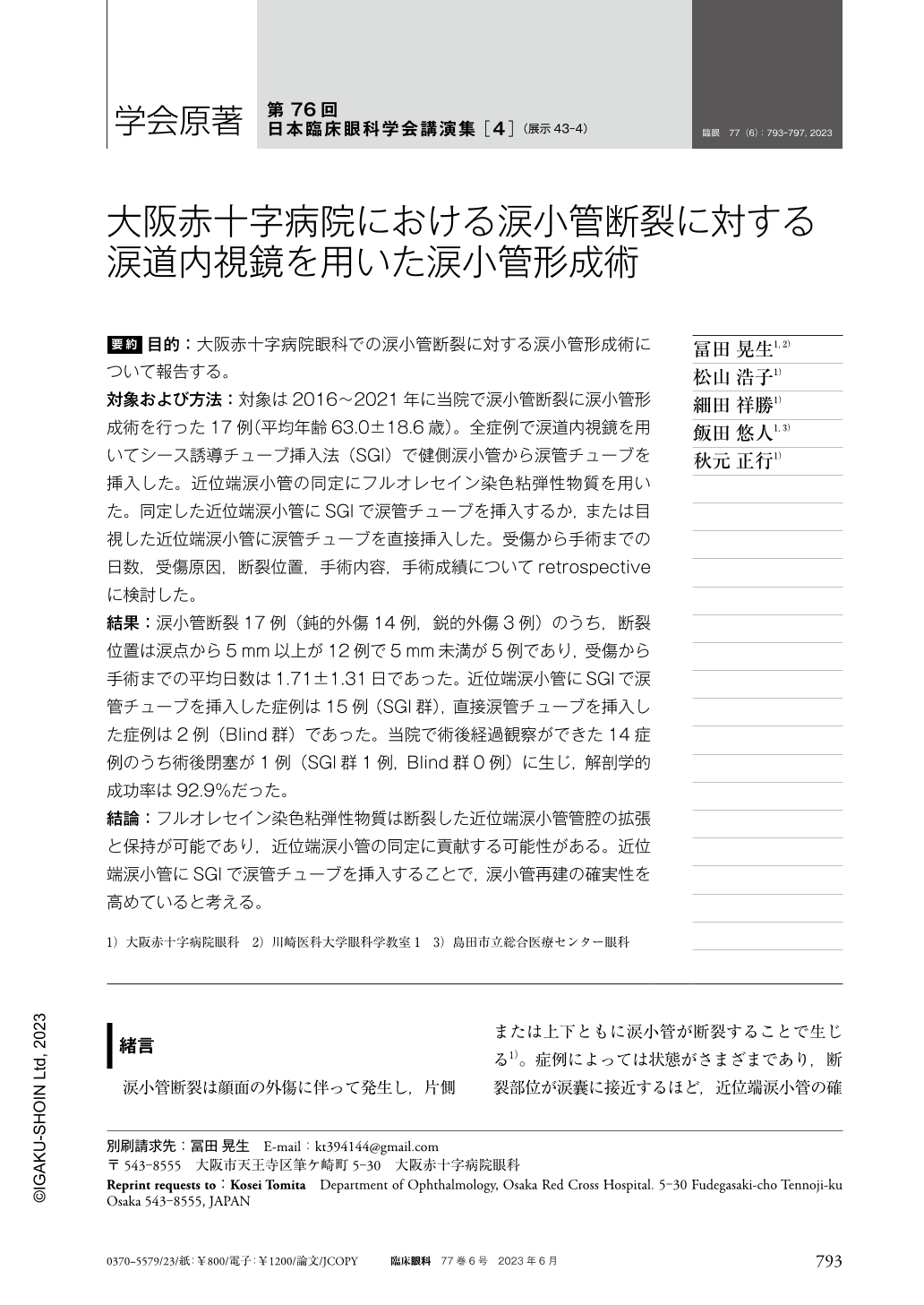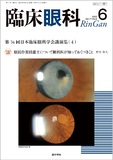Japanese
English
- 有料閲覧
- Abstract 文献概要
- 1ページ目 Look Inside
- 参考文献 Reference
要約 目的:大阪赤十字病院眼科での涙小管断裂に対する涙小管形成術について報告する。
対象および方法:対象は2016〜2021年に当院で涙小管断裂に涙小管形成術を行った17例(平均年齢63.0±18.6歳)。全症例で涙道内視鏡を用いてシース誘導チューブ挿入法(SGI)で健側涙小管から涙管チューブを挿入した。近位端涙小管の同定にフルオレセイン染色粘弾性物質を用いた。同定した近位端涙小管にSGIで涙管チューブを挿入するか,または目視した近位端涙小管に涙管チューブを直接挿入した。受傷から手術までの日数,受傷原因,断裂位置,手術内容,手術成績についてretrospectiveに検討した。
結果:涙小管断裂17例(鈍的外傷14例,鋭的外傷3例)のうち,断裂位置は涙点から5mm以上が12例で5mm未満が5例であり,受傷から手術までの平均日数は1.71±1.31日であった。近位端涙小管にSGIで涙管チューブを挿入した症例は15例(SGI群),直接涙管チューブを挿入した症例は2例(Blind群)であった。当院で術後経過観察ができた14症例のうち術後閉塞が1例(SGI群1例,Blind群0例)に生じ,解剖学的成功率は92.9%だった。
結論:フルオレセイン染色粘弾性物質は断裂した近位端涙小管管腔の拡張と保持が可能であり,近位端涙小管の同定に貢献する可能性がある。近位端涙小管にSGIで涙管チューブを挿入することで,涙小管再建の確実性を高めていると考える。
Abstract Purpose:To report the surgical outcome of canalicular laceration repair using lacrimal endoscopy.
Methods:We retrospectively reviewed the medical records of 17 consecutive patients diagnosed with canalicular laceration who underwent canalicular reconstruction between 2016 and 2021. The mean patient age at the time of surgery was 63.0±18.6 years. In all cases, a silicone tube was inserted through the healthy canaliculus by sheath-guided intubation(SGI)through lacrimal endoscopy. A fluorescein-stained viscoelastic substance was used to identify the proximal end of the canaliculus.
The timing of surgery, type of injury, distance from the distal lacerated end of the canaliculus to the punctum, surgical details and, the surgical outcome were retrospectively reviewed.
Result:The causes of injury were blunt trauma in 14 cases and sharp trauma in three. Distances from the distal cut end to the punctum was of more than 5 mm in 12 cases and of 5 mm or less in five. The timing of surgery was 1.71±1.31 days. There were 15 cases in which SGI was performed into the proximal end of the canaliculus(SGI group)and in two cases a direct tear duct tube was inserted into the proximal end of the canaliculus(Blind group). Of the 14 patients who could be followed up postoperatively at our hospital, postoperative obstruction occurred in one case(one in the SGI group and none in the Blind group), and the anatomical success rate was 92.9%.
Conclusion:Fluorescein-stained viscoelastic substance is capable of expanding and maintaining the lumen of canalicular laceration and may contribute to the identification of the proximal end of the canaliculus. We believe that the insertion of a silicone tube into the proximal end of the canaliculus with SGI enhances the probability of successful canalicular reconstruction.

Copyright © 2023, Igaku-Shoin Ltd. All rights reserved.


